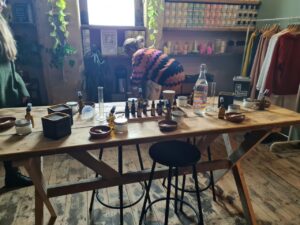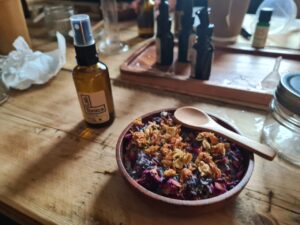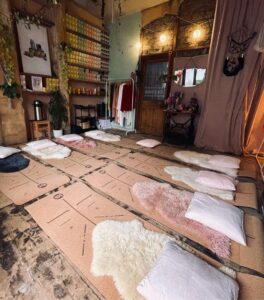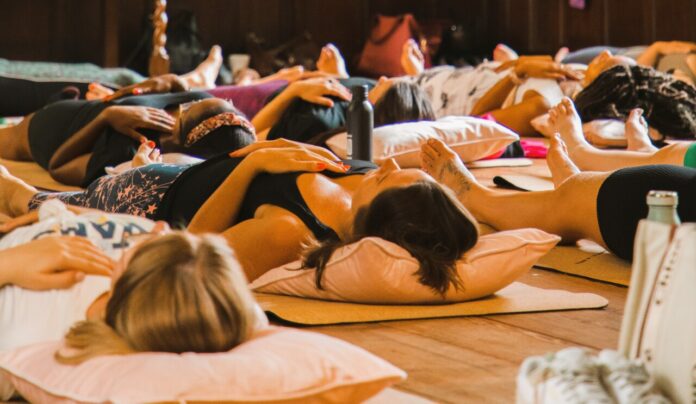It’s 5 am, and I’m fully awake. For the fifth time in a row, I wake up hours before my alarm goes off, my racing heart keeping me from falling back to sleep.
While staring at the ceiling, I decide that my sleep problems have to stop, and I get my laptop out in the middle of the night to browse for sleep workshops.
Over ten sleep and calming workshops pop up on my screen, but one in East London catches my eye. Kitty McEntee, the founder of LabTonica, is hosting a relaxing sleep workshop in her shop in Hackney, East London. I already know Kitty from a day retreat she hosted in the summer. As I loved her previous workshop, I decide to try her sleep workshop, hoping it will help me with my sleep problems.
As a live-in nanny, student, blogger, and reporter, I have a lot on my plate. I never noticed how many responsibilities I had, as it always seemed easy for me to handle everything. But last week, I couldn’t take it anymore. I started work at 7 am and ended my day with uni work at 9 pm. Because of my racing mind, which thinks about all the things I have to get done, I woke up with that racing heart and decided that things had to change.
It is recommended that adults get 7-9 hours of sleep every night. But in reality, almost one in five adults in the UK aren’t getting enough sleep. The Great British Sleep Survey of 2020 highlights that 36.1% of people in the UK struggle to fall asleep, and 41.25% wake up frequently at night.
57% of 18- to 24-year-olds say they feel tired when they wake up in the morning. Poor sleep can affect our mental and physical health. One of the biggest problems is sleep deprivation, which is associated with poor mood and an inability to control our emotions.
My sleep problems started in my final years of school when I was 17 years old, preparing for my A levels. The pressure of studying five different subjects at a time stressed me out. I couldn’t fall asleep or even if I did I woke up multiple times in the night. That’s when I started building up strategies to help me get enough the rest at night. Yoga, exercising and meditation helped me through my A levels. But when I tried my techniques again, when my university work and deadlines caused sleepless nights, it didn’t help me anymore.
So on a cloudy and grey Wednesday evening, after an exhausting day of going to university and then working with kids for five hours, we all meet in Kitty’s pop-up shop in Hackney. Here she usually sells her herbal teas and essential oil blends. But tonight the shop looks magical, adorned with a big wooden table prepared wooden bowls and spoons, essential oils, and spray bottles.

From the moment I enter, I feel welcome and safe. Kitty immediately recognises me from the summer workshop and greets me with a big smile and a hug. Ten minutes later, five other women and one man have arrived, and we introduce ourselves with a warm cup of herbal tea.
The women are all older than me, and everyone has their own reasons why they can’t sleep at night. One of them was expecting her first child. The oldest lady works at a dentist and never has time to do things just for herself. A blond woman called Jenny has two children and a time-consuming job in the fashion business. The one man amongst us tells us that his mother was so excited about Kitty’s teas that he wanted to try them for himself.
Kitty is wearing funky and comfortable leggings-and-jumper combo in bright orange and black. She tells us about her shop, which has no electricity or water as it is so old. It used to be a renowned sweets shop in that area. People have often entered her shop and told her how much they loved buying sweets there in their childhood. The floor is squeaky. I can feel the cold air coming through little cracks in the wood on the walls and listen to the rain pitter-patter on the windows as we start our dreamy sleep workshop by blending our own unique pillow mist.
While we all find a spot around the table, Kitty tells us where her passion for herbal medicine came from. “My journey of discovery reignited memories from childhood of the stories my mum would tell me about her maternal grandmother, Louisa.” She says her great-grandmother Louisa was renowned in her village as a healer, and would, “create things in the garden” to help people with their ailments. “Some of the magic and passion that Louisa had has perhaps been passed down to me,” she says.
Kitty had a 15-year career in the advertising industry, which she said was fun but also very stressful, causing her panic attacks. While drinking chamomile tea one day, she realised how old-fashioned and dated most herbal tea packs looked. Kitty then enrolled on a herbal medicine degree. She spent two and half years studying, and creating Lab Tonica which she launched in February 2021.
We all start by smelling the essential oils Kitty has prepared for us, and choose the ones we love most to go into our pillow mist. Kitty tells us that it is vital to produce a balanced scent profile, with the correct base, mid and top notes to create a unique and pleasing scent. When she explains it, everything makes sense. But when we start mixing the oils, I have already forgotten what a base note is and which essential oils are top notes, but I pretend I know what I am doing.

The oils I choose all work on the nervous system to soothe and calm. They are known as ‘calmative’ oils. I use a lot of lavender, an ‘analgesic’ that helps relieve pain, making your body relaxed and comfortable for sleep. Next, I use a few drops of jasmine, one of my favourite essential oils. Lavender and jasmine are also ‘sedative’ plants that help reduce and ‘turn off’ overactive neurotransmitters in the brain – which can be one of the key reasons we find it difficult to sleep at night.
Then 4 drops of Myrrh and sandalwood. They work on the limbic part of the brain and support feelings of happiness and well-being, reducing negative thoughts and worry. And last but not least, one drop of Eucalyptus. It works on the upper respiratory tract to soothe inflamed airways and unblock sinuses, helping us breathe deeply and calmly when we sleep.

Even if you haven’t purchased essential oils, you probably have used them anyway. VapoRub, for example, contains essential oils like eucalyptus and nutmeg oils. Many people swear by their mood-lifting abilities.
The use of essentials oils dates back thousands of years. But according to The Scientific American “Currently, there is no evidence-backed research showing any illnesses that can be cured through the use of essential oils or the practice of aromatherapy. The results on the other possible benefits of essential oils as, for example, mood elevators or stress relievers, are more mixed. But most are still inconclusive”.
After smelling so many different essential oils, I can’t smell any difference between them anymore. So I ask Kitty what she thinks of my blend. She says the combination I created has a lovely deep base, long lavender mid notes and a fresh and clean top finish. I trust her opinion because she always let the others know when some of their notes are too strong.
After the pillow mist session, we get yoga mats and pillows out. Nix Brook, a breathwork facilitator who has joined us for the pillow mist blending, teaches us a breathing exercise to ground your energies. Nix always has a big smile on her face and a soft voice, which makes it easy to follow her. She explains that this practice can help with calming down, mental health, anxiety and tackling sleep issues. Nix does breathing exercises multiple times throughout the day.

Throughout history, humans used breathing exercises to improve their mental health and reduce stress. It’s an ancient practice dating back thousands of years. It has roots in eastern practices like yoga, Thai Chi and Buddhism. Swami Vivekananda introduced breathwork to western cultures in the 19th century. He was an Indian Hindu monk, philosopher, author, and teacher. However, the breath work therapy we know today started during the “consciousness-raising era” in the 1960s and 1970s. Many types of breathwork were formed during this era, some of which are about self-awareness and inner peace while others are focused on the “traumatic experience of birth”.
Tonight, Nix gives guides us through an easy-breathing exercise for beginners. Conscious connected breathing is, like the name suggests, a technique through which you breathe consciously through your mouth. You lie on a mat, close your eyes, open your mouth wide, and breathe into your lower abdomen, before a passive exhale. It is essential to consciously connect the inhale and exhale without any pause, so that it becomes a wave.
At first, it feels unfamiliar to only breathe through my mouth. And honestly, I feel uncomfortable making these noises and having my mouth open while breathing. It takes a lot of willpower to stop thinking how ridiculous I might sound and look. But with Nix’s help in finding my rhythm, it starts feeling natural and freeing. Nix points out that every breath work journey is unique and that you can sometimes experience suppressed emotions coming up, and release energy in the form of a yawn.
While I don’t burst into tears, the breath work does have an effect on me. In the first 20 minutes I struggle a lot; it feel like I have an enormous weight on my chest, preventing me from breathing. I yawn a bit in the middle, and towards the end I feel tingles all over my face. I enter a state of zero thoughts – which is absolute bliss compared to when my mind constantly races, telling me what I need to do: coursework and looking after the children.
With a warm hug, Kitty says goodbye to me. After the workshop I fly home. That’s how light and relaxed I feel. As it is pretty late when I’m back home, about 10pm, I go straight to bed, excited to see whether the sleep workshop will still that racing mind at night.
I spritz my self-made pillow mist all over my bed, have a calming herbal tea and fall asleep much faster than usual. Maybe I am just very exhausted, but I have not started going through my endless to-do list, or thinking about stupid things I did ten years ago instead of sleeping. Obviously, I will have to practice conscious breathing regularly over some time to see if there are any long-term results.
The evening with Kitty and Nix was relaxing and enlightening – especially after such a stressful month of work and anxiety. In the end, there is one question: did this experiment work, or did I want it to work so badly that it did for one night?
I don’t know the answer to that yet. But I do know that it will be challenging to incorporate Kitty’s new routine into my life. I’m not sure I will feel like breathing my way into sleep every night.
I paid £30 for the workshop, which was definitely worth it. Of course I could make essential oils myself, and mix a pillow mist at home.
But I’ve got enough on my plate already! And being in such a beautiful shop with people I had never met before, making pillow mists and talking about life, was much more fun.
All photos by Mai Pfeiffer

